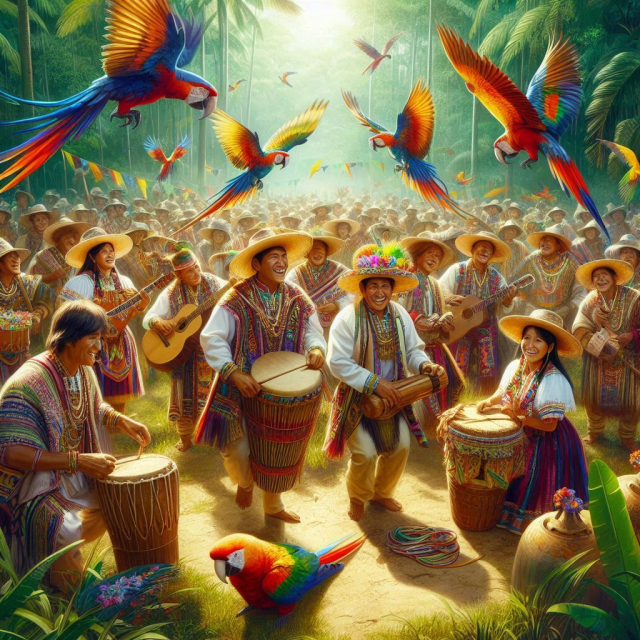Ecuador is a country rich in cultural diversity, home to a variety of indigenous tribes that have maintained their traditions and ways of life throughout the centuries. These communities, each with their unique customs and practices, play a fundamental role in the country's cultural identity. In this article, we will explore the lifestyle of some of the main indigenous tribes of Ecuador, highlighting their customs, beliefs, economy, and contemporary challenges.
Indigenous Tribes of Ecuador.
Ecuador is home to more than a dozen indigenous groups, each with their own language, culture and traditions. Among the best known are the Kichwa, Shuar, Huaorani, Achuar, and Secoya, among others. These tribes reside in diverse regions, from the high mountains of the Andes to the dense jungles of the Amazon.
The Kichwa.
Location and Population.
The Kichwa are the largest indigenous group in Ecuador, living mainly in the Andean region and parts of the Amazon. The Kichwa population is diverse and is divided into several communities, each with its own particularities.
Customs and traditions.
The Kichwa have a rich oral tradition, and their myths and legends are an integral part of their culture. They celebrate several festivals, such as Inti Raymi (Festival of the Sun) and Pawkar Raymi (Flowering Festival), which mark agricultural cycles and seasonal changes. Their rituals often include music, dance, and offerings to Pachamama (Mother Earth).
Economy and Sustainability.
The Kichwa economy is based mainly on subsistence agriculture. They grow corn, potatoes, quinoa, and other products, using traditional techniques that respect and conserve the environment. In the Amazon, some Kichwa groups also practice fishing and collecting wild fruits.
The Shuar.
Location and Population.
The Shuar live in the Amazon region, especially in the provinces of Morona Santiago and Pastaza. With a population of around 100,000 people, they are one of the most representative tribes of Eastern Ecuador.
Customs and traditions.
The Shuar are known for their hunting and gathering skills, as well as their horticultural practices. Traditionally, they live in communal houses called "cankus" and maintain a social organization based on extended families. They celebrate various rituals and festivities, one of the most important being the "Uwi Tsantsa", related to hunting and war, although currently it focuses more on cultural identity.
Economy and Sustainability.
The Shuar economy includes agriculture, hunting, and gathering. They grow cassava, banana, and corn, and are known for fishing with barbasco, a plant they use to stun fish. Sustainability is key to their lifestyle, and their farming and hunting practices are designed to ensure that natural resources are maintained over time.
The Huaorani.
Location and Population.
The Huaorani live in the Amazon rainforest, mainly in the province of Orellana and in the protected area of the Yasuní National Park. Its population is approximately 2,500 people.
Customs and traditions.
The Huaorani have a close relationship with their natural environment. They are expert hunters and gatherers, using blowguns and spears to hunt. They live in small communities and their homes are simple, made of natural materials. The Huaorani worldview focuses on respect and connection with nature, and their myths and legends reflect this relationship.
Economy and Sustainability.
The Huaorani economy is mainly subsistence, based on hunting, fishing, and the collection of fruits and medicinal plants. Sustainability is essential in their way of life, and their practices are aimed at not depleting the forest's resources.
Contemporary Challenges.
Despite their cultural richness and sustainable traditions, Ecuador's indigenous tribes face numerous challenges. Deforestation, natural resource extraction, and pressure for modernization threaten their way of life. Territorial conflicts with oil and mining companies are common, and the resulting pollution affects both the environment and the health of these communities.
Additionally, globalization and cultural change put pressure on younger generations, who are often torn between maintaining ancient traditions and adapting to the modern world. Lack of access to basic services such as education and health is also a significant problem in many indigenous communities.
Conservation and Support Initiatives.
Fortunately, there are various initiatives both locally and internationally to support the indigenous communities of Ecuador. Non-governmental organizations and international cooperation programs work together with communities to promote sustainable development and cultural conservation.
Eco-tourism projects.
Eco-tourism is one of the strategies adopted by several indigenous communities to generate income in a sustainable way. Community tourism projects allow visitors to learn about indigenous cultures and their relationship with nature, while providing economic resources for local communities.
Intercultural Education.
Intercultural bilingual education is another crucial initiative. This educational system seeks to teach indigenous children in their native language and in Spanish, respecting and promoting their cultures. Intercultural education not only improves access to education, but also strengthens cultural identity and empowers communities to face contemporary challenges.
Protection of Ancestral Territories.
The protection of ancestral territories is essential for the cultural and physical survival of indigenous communities. Several organizations work to ensure that the land rights of indigenous tribes are recognized and respected. This includes the creation of protected areas and legal defense against unauthorized exploitation of their lands.
The lifestyle of Ecuador's indigenous tribes is a testament to cultural diversity and human resilience. Despite contemporary challenges, these communities keep their traditions and connection with nature alive. The preservation of their culture and the protection of their territorial rights are essential not only for them, but also for the biodiversity and cultural wealth of the planet. Through conservation initiatives, intercultural education and eco-tourism, there is hope that these communities can thrive and continue to be guardians of their invaluable cultural and natural heritage.
